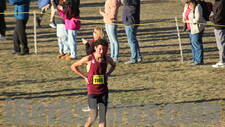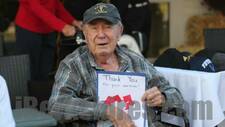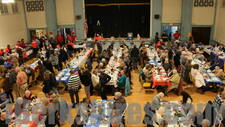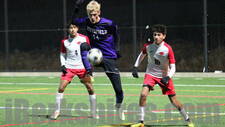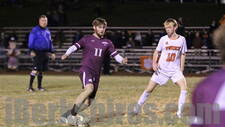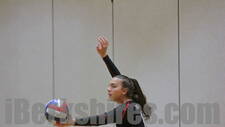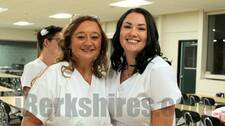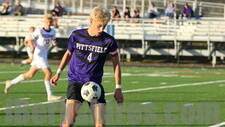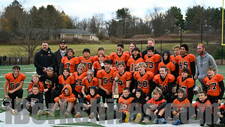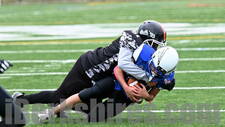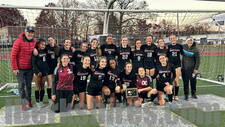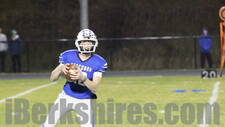iBerkshires.com Columnist SectionSue Bush
More articles from Sue Bush
Safe Seats For Traveling KidsBy Susan Bush
12:00AM / Saturday, June 17, 2006
 | | Child safety seat technicians at work during a June 17 safety seat checkpoint event held at the Charles H. McCann Technical High School. |
North Adams - First-time father Jim Barrett waited in line during a June 17 child safety seat installation checkpoint held at the Charles H. McCann Technical School.
Barrett's wife Shannon delivered newborn son Ty earlier in the week and Barrett wanted to be certain the infant's car seat was properly installed prior to bringing his son home.
Shannon Barrett operates a child care center and owns five child safety seats, but the one purchased for Ty seemed to operate differently from the others, Jim Barrett said.
"So we wanted to be certain that we have everything right," he said.
Lots Of Variations

Robert Dobbert adjusts a "tether" as part of a child safety seat checkpoint. |
The Barretts' discovery that their new seat worked differently than seats they'd already used is a common occurrence and underscores the need for safety seat checkpoints, according to Mandi Summers and Magda Rodriguez, both of the Safe Kids of Western Mass. organization.
Rodriguez and Summers are certified to install child safety seats and also teach 40-hour classes that are required to earn certification as a child safety seat installation technician. They were among the volunteers at the Saturday checkpoint.
"There are lots of variations [in safety seats and vehicles]," Summers said, and added that there are older model vehicles still being driven that are not able to accommodate the mandatory child-transportation seats at all.
Car seat mechanisms differ from model to model and parents, grandparents, or anyone who transports children may become confused or frustrated by the differences. There are over 100 child car safety seat manufacturers, Summers said.
"So we have many cars that are different and many car seats that are different."
There is also no "master list" that details which car seats are compatible with which make and model of vehicle, Summers said.
Consumers may ask a store clerk to accompany them to their vehicle and check for car seat compatibility prior to making a purchase. Most stores will allow an exchange if a seat is purchased and then does not fit the vehicle, if proper documentation of a purchase can be provided at the time of the exchange.
Most motor vehicles have been built with adult amenities as a priority, Summers said.
"A lot of cars are built for adult comfort and to encourage seat belt use in adults," she said.
In Cars, At Risk
But it's children who may be most at risk during a vehicle crash; according to information provided by a checkpoint co-sponsor, the REACH Community Health Foundation, 2,000 children under age 14 are killed each year as a result of vehicle crashes and 280,000 receive injuries due to vehicle collisions. According to the information, 57 percent of the deaths occurred among children who were not restrained while riding in a vehicle. Infant, toddler, and child booster seats reduce the risks significantly, but must be properly installed to generate the most benefit.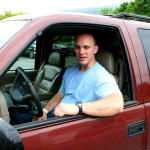
Jim Barrett of North Adams made certain a seat to be used by his newborn son was properly installed. |
Various studies have indicated rampant misuse of child safety seats; a Safe Kids Worldwide analysis conducted at specific Massachusetts "Safe Kids Buckle Up" events from April 2001 to Oct. 2001 showed that 64.6 percent of child vehicle seats were incorrectly used. A study by the National Safe Kids Campaign focused on 17,500 child car seats and found that 85 percent of the seats were being misused, according to information provided by REACH.
Summers noted that there is a push to manufacture most seats with a universal latching mechanism. Trying to establish an overall one-style-fits-all safety seat design may be almost impossible, she added.
"A vehicle fleet takes about 20 years to turn over, so even if the [car seat] models were made all the same, there would still be problems," she said.
Comin' Through
The checkpoint didn't lack for participants. By noontime, over 20 vehicles, many hosting more than one child safety seat, had passed through the technician-staffed stations. The event began at 10 a.m. and ended at 2 p.m..
On-site certified technicians included Massachusetts College of Liberal Arts campus Officer Jared Ciempa, North Adams Ambulance Service EMT Robert Dobbert, Adams police Officer Timothy Carpenter, Pittsfield police Officer Charles Bassett, Pittsfield firefighters Don Whalen and Jeffrey Giacoletto, and J.D. Hebert, director of transportation for the Berkshire Community Action Council.

Adams police Officer Timothy Carpenter worked through a checkpoint checklist. |
"We transport children for the Berkshire Center for Families and for Berkshire Child Care," Hebert said. "We transport about 500 children a month. I'm up here helping out with the checkpoint installations and I'm trying to launch some checkpoints in Pittsfield."
Patricia Skorupski joined the checkpoint line just past noontime.
She recently welcomed a new granddaughter and decided that the infant safety seat installation was something that couldn't be a probable, as in "probably" properly secured.
"This is a good way to make sure that everything is OK," she said. "I definitely want things to be right with the car seat."
Vicki DesChamps of the Northern Berkshire Women, Infants, and Children nutrition program [WIC], an event co-sponsor, and Becky Krysiak of Child Care of the Berkshires offered additional information about child safety issues including lead poisoning and other issues. McCann student and Students Against Destructive Decisions [SADD] member Sarah Betty was a checkpoint volunteer.
Krysiak said that the child care agency is hoping to organize another checkpoint during October. Checkpoints could be offered twice a year on a regular basis, she said.
Local Groups Offer Help
Sharon Leary of REACH said the checkpoints are valuable community resources.
"We are making certain that our children are safe for the summer," she said. "We've had about 20 cars come through and if I only had one [vehicle] I'd be happy because it would mean one more child was safe."
Area Elks and Lions Club organizations, along with members of a St. Vincent du Paul conference donated funds to purchase several child safety seats, Leary said.
The seats may be used to assist families who cannot afford to replace seats that are under a mandatory safety recall or are over six years old [the recommended seat replacement criteria], or may be used when a family cannot afford a seat at the time of a child's birth. Babies born at the North Adams Regional Hospital may not leave the hospital without an appropriate safety seat installed in the transporting vehicle, Leary said.
Pittsfield firefighter Jeff Giacoletto checked the child safety seat in Jim Barrett's vehicle. |
Infant/Convertible Seats
Infants should ride in rear-facing infant-only or convertible seats until they are at least one year old and have reached a minimum weight of 20 pounds. The American Academy of Pediatrics recommends keeping children rear-facing in convertible car seats until they reach the upper height or upper weight limit of the specific seat model, or until the child's head reaches within one inch of the top of the seat.[information from www.baystatehealth.com/safekids]
Forward-Facing Car Seats
Children can use forward-facing seats until they reach four years of age and a weight of 40 pounds. There are some forward-facing seats that established a 65-pound weight limit with a harness.[information from www.baystatehealth.com/safekids]
Booster Seats
Booster seats are for children who have outgrown a convertible seat and are not big enough to correctly use a seat belt. Booster-weight children are between 40 pounds and 80-100 pounds, under 4'9'' tall, and are usually between the ages of four and eight. A booster seat can protect a child from spinal cord and internal injuries that can be caused by improper seat belt use.[information from www.baystatehealth.com/safekids]
Seat Belts
Lap and shoulder seat belts should be used by children who have grown too big for booster seats. Lap belts should fit across the hips and should not push up over the stomach. Shoulder belts should not cross over necks or faces but should fit along the mid-point of the shoulder.[information from www.baystatehealth.com/safekids]
Susan Bush may be reached via e-mail at suebush@iberkshires.com or at 802-823-9367.
|
|
Advertise on
iBerkshires.com
|







